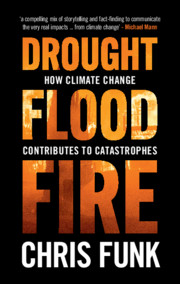Book contents
- Drought, Flood, Fire
- Drought, Flood, Fire
- Copyright page
- Contents
- Acknowledgments
- 1 Climate Extremes, Climate Attribution, Extreme Event Attribution
- 2 Welcome to an Awesome Planet
- 3 The Earth Is a Negentropic System, or “the Bright Side of Empty”
- 4 Do-It-Yourself Climate Change Science
- 5 Temperature Extremes – Impacts and Attribution
- 6 Precipitation Extremes
- 7 Hurricanes, Cyclones, and Typhoons
- 8 Conceptual Models of Climate Change and Prediction, and How They Relate to Floods and Fires
- 9 Climate Change Made the 2015–2016 El Niño More Extreme
- 10 Bigger La Niñas and the East African Climate Paradox
- 11 Fire and Drought in the Western United States
- 12 Fire and Australia’s Black Summer
- 13 Driving toward +4°C on a Dixie® Cup Planet
- 14 We Can Afford to Wear a White Hat
- Appendix A Few Resources for Further Reading and Research
- Index
7 - Hurricanes, Cyclones, and Typhoons
Published online by Cambridge University Press: 01 June 2021
- Drought, Flood, Fire
- Drought, Flood, Fire
- Copyright page
- Contents
- Acknowledgments
- 1 Climate Extremes, Climate Attribution, Extreme Event Attribution
- 2 Welcome to an Awesome Planet
- 3 The Earth Is a Negentropic System, or “the Bright Side of Empty”
- 4 Do-It-Yourself Climate Change Science
- 5 Temperature Extremes – Impacts and Attribution
- 6 Precipitation Extremes
- 7 Hurricanes, Cyclones, and Typhoons
- 8 Conceptual Models of Climate Change and Prediction, and How They Relate to Floods and Fires
- 9 Climate Change Made the 2015–2016 El Niño More Extreme
- 10 Bigger La Niñas and the East African Climate Paradox
- 11 Fire and Drought in the Western United States
- 12 Fire and Australia’s Black Summer
- 13 Driving toward +4°C on a Dixie® Cup Planet
- 14 We Can Afford to Wear a White Hat
- Appendix A Few Resources for Further Reading and Research
- Index
Summary
Our Blue Marble's unique temperature range supports water in all its three glorious phases (solid, liquid, gas). Phase transitions between liquid water and water vapor involve tremendous amounts of energy, and this energy helps fuel hurricanes. Sweeping across warm waters, winds can gather water from a vast stretch, sometimes to catastrophic effect. For example, Hurricane Harvey pummeled Houston with 9 trillion gallons of water, releasing about 76 x 1018 Joules of energy. Harvey was joined by Mathew, Maria, Irma, Florence, Michael, Dorian, and Imelda. According to NOAA data, in 2015–2019, extreme hurricanes caused $315 billion in damages. Between 2000 and 2019, these extremes caused $746 billion in damages. Climate change attribution for cyclones is difficult, given their complexity and rarity. A summary of a recent World Meteorological Organization study introduces event “detection” and “attribution,” as well as the new “storyline” approach to event attribution. Like an autopsy, storyline attribution can indicate whether climate change was one probable cause of an extreme event. From this perspective, climate change has likely contributed to the increased frequency and intensity of exceptionally strong hurricanes. The chapter concludes by discussing two important storyline attribution studies focused on very strong Atlantic hurricanes.
Keywords
- Type
- Chapter
- Information
- Drought, Flood, FireHow Climate Change Contributes to Catastrophes, pp. 140 - 163Publisher: Cambridge University PressPrint publication year: 2021

